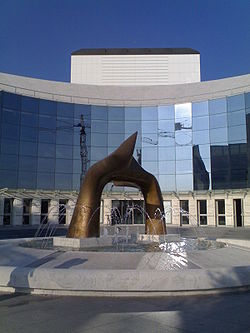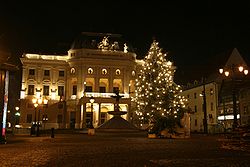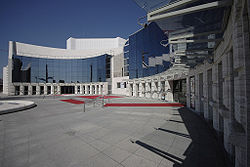
Slovak National Theatre
Encyclopedia


- the oldest SlovakSlovakiaThe Slovak Republic is a landlocked state in Central Europe. It has a population of over five million and an area of about . Slovakia is bordered by the Czech Republic and Austria to the west, Poland to the north, Ukraine to the east and Hungary to the south...
professional theatre consisting of 3 ensembles (operaOperaOpera is an art form in which singers and musicians perform a dramatic work combining text and musical score, usually in a theatrical setting. Opera incorporates many of the elements of spoken theatre, such as acting, scenery, and costumes and sometimes includes dance...
, balletBalletBallet is a type of performance dance, that originated in the Italian Renaissance courts of the 15th century, and which was further developed in France and Russia as a concert dance form. The early portions preceded the invention of the proscenium stage and were presented in large chambers with...
and dramaDramaDrama is the specific mode of fiction represented in performance. The term comes from a Greek word meaning "action" , which is derived from "to do","to act" . The enactment of drama in theatre, performed by actors on a stage before an audience, presupposes collaborative modes of production and a...
), - a Neo-RenaissanceNeo-RenaissanceRenaissance Revival is an all-encompassing designation that covers many 19th century architectural revival styles which were neither Grecian nor Gothic but which instead drew inspiration from a wide range of classicizing Italian modes...
theatre building in the Old Town of BratislavaBratislavaBratislava is the capital of Slovakia and, with a population of about 431,000, also the country's largest city. Bratislava is in southwestern Slovakia on both banks of the Danube River. Bordering Austria and Hungary, it is the only national capital that borders two independent countries.Bratislava...
, Slovakia, which formerly housed two of the theatre's ensembles (opera and ballet, drama was based elsewhere), and - the theatre's large modern theatre building in Bratislava near the DanubeDanubeThe Danube is a river in the Central Europe and the Europe's second longest river after the Volga. It is classified as an international waterway....
, which opened on 14 April 2007.
Professional theatre
The Slovak National Theatre is the second oldest Slovak professional theatre. It has 3 ensembles (drama, opera and ballet). It was founded in 1920 after the creation of CzechoslovakiaCzechoslovakia
Czechoslovakia or Czecho-Slovakia was a sovereign state in Central Europe which existed from October 1918, when it declared its independence from the Austro-Hungarian Empire, until 1992...
as a cooperative and became a state-run company in 1945. Between 1920 and 1945, there was also a musical ensemble. The Slovak National Theatre has represented Slovak culture
Slovaks
The Slovaks, Slovak people, or Slovakians are a West Slavic people that primarily inhabit Slovakia and speak the Slovak language, which is closely related to the Czech language.Most Slovaks today live within the borders of the independent Slovakia...
on its numerous tours abroad.
It was created and, in the 1920s, also run by Czech
Czech people
Czechs, or Czech people are a western Slavic people of Central Europe, living predominantly in the Czech Republic. Small populations of Czechs also live in Slovakia, Austria, the United States, the United Kingdom, Chile, Argentina, Canada, Germany, Russia and other countries...
artists (e.g. Oskar Nedbal
Oskar Nedbal
Oskar Nedbal was a Czech violist, composer, and conductor of classical music.-Life:Nedbal was born in Tábor, in southern Bohemia. He studied the violin at the Prague Conservatory under Antonín Bennewitz...
, director during 1923-1930). The first performance was the Czech opera Hubička
The Kiss (opera)
The Kiss is an opera in two acts, with music by Bedřich Smetana and text by Eliška Krásnohorská, based on a novel by Karolina Světlá. It received its first performance in Prague on November 7, 1876.- Roles :- Act I :...
by Bedřich Smetana
Bedrich Smetana
Bedřich Smetana was a Czech composer who pioneered the development of a musical style which became closely identified with his country's aspirations to independent statehood. He is thus widely regarded in his homeland as the father of Czech music...
on March 1, 1920. The ensembles were Slovakized only gradually. In 1932, the drama ensemble split into the SNT Slovak Drama Company led by Janko Borodáč, and into the SNT Czech Drama Company, led by V. Šulc. The Czech Drama Company ceased to operate when it was forced to leave Slovakia in 1938. Since then, the drama ensemble has performed in Slovak
Slovak language
Slovak , is an Indo-European language that belongs to the West Slavic languages .Slovak is the official language of Slovakia, where it is spoken by 5 million people...
only, but in the opera ensemble there were Czech artists even after 1945. In recent years, operas have been presented in their original languages.
Initially, all 3 ensembles were active at the old Slovak National Theatre building. From 1955 to early 2007, the drama company performed at the P. O. Hviezdoslav Theatre and from 1962 to (?)2006 also at a chamber theatre called Malá scéna SND (SNT Small Stage). Since 2007, the ensembles perform only at the old Slovak National Theatre building and the new Slovak National Theatre building opened in April, 2007.
The drama company was shaped by the directors Janko Borodáč, F. Hoffman, J. Jamnický, J.Budský, T. Rakovský, K. I. Zachary, P. Haspra, M. Pietor and the current one – Dušan Jamrich.
The opera ensemble was led by conductors such as Oskar Nedbal
Oskar Nedbal
Oskar Nedbal was a Czech violist, composer, and conductor of classical music.-Life:Nedbal was born in Tábor, in southern Bohemia. He studied the violin at the Prague Conservatory under Antonín Bennewitz...
, K. Nedbal, J. Vincourek and T. Frešo, and directors including V. Šulc and M. Wasserbauer. The opera became known abroad under the leadership of Czech conductor Oskar Nedbal, who also introduced the first Slovak operas of Jozef Levoslav Bella and V. Figuš Bystrý, and under K. Nedbal, who improved the dramma programme. A great boom occurred after WWII. The SNT witnessed the rise of modern Slovak opera by Eugen Suchoň
Eugen Suchon
Eugen Suchoň was one of the greatest Slovak composers of the 20th century.-Early life:...
, Ján Cikker
Ján Cikker
Ján Cikker was a Slovak composer, a leading exponent of modern Slovak classical music. He was awarded the title National Artist in Slovakia, the Herder Prize and the UNESCO Prize .-Life:...
, Alexander Moyzes
Alexander Moyzes
Alexander Moyzes , was a Slovak 20th century neoromantic composer.-Biography:Moyzes was born into a musical family in 1906 at Kláštor pod Znievom in present Slovakia. His father was the composer and educator Mikuláš Moyzes...
, Tibor Andrašovan, T. Frešo, and many others. Many singers from the SNT are famous abroad, e.g. Edita Grúberová
Edita Gruberová
Edita Gruberová , is a Slovak soprano who is one of the most acclaimed coloraturas of recent decades. She is noted for her great tonal clarity, agility, dramatic interpretation, and ability to sing high notes with great power, which made her an ideal Queen of the Night in her early years...
, Lucia Popp
Lucia Popp
Lucia Popp was a notable Slovak operatic soprano. She began her career as a soubrette soprano, and later moved into the light-lyric and lyric coloratura soprano repertoire and then the lighter Richard Strauss and Wagner operas. Her career included performances at Vienna State Opera, the...
, Peter Dvorský
Peter Dvorský
Peter Dvorský is a Slovak operatic tenor. Possessing a lyrical voice with a soft, elastic tone, and warm and melodious timbre, Dvorský's repertoire concentrates on roles from the Italian and Slavic repertories....
, R. Petrák, S. Kopčák, M. Hajóssyová, E. Jenisová, J. Galla, Jozef Kundlák
Jozef Kundlák
Jozef Kundlák is a Slovak tenor.-Early career:Kundlák was born in Bratislava and studied at the Conservatory in Bratislava in Prof. Ida Černecka's class. After finishing his studies he participated in the Summer Opera Course of the European Opera Center in Belgium in 1984...
, and many others.
The ballet ensemble has grown from a small group in 1920 to a huge ensemble today.
The old building
This theatre's names were earlier: City Theatre (-)
today's Hviezdoslav
Hviezdoslavovo námestie (Bratislava)
Hviezdoslavovo námestie is one of the best-known squares in Bratislava. It is located in the Old Town, between the New Bridge and the Slovak National Theatre.The square is named after Pavol Országh Hviezdoslav.-History:...
Square, was built in 1885–1886 during the time of Austria-Hungary
Austria-Hungary
Austria-Hungary , more formally known as the Kingdoms and Lands Represented in the Imperial Council and the Lands of the Holy Hungarian Crown of Saint Stephen, was a constitutional monarchic union between the crowns of the Austrian Empire and the Kingdom of Hungary in...
, based on a design by the Viennese
Vienna
Vienna is the capital and largest city of the Republic of Austria and one of the nine states of Austria. Vienna is Austria's primary city, with a population of about 1.723 million , and is by far the largest city in Austria, as well as its cultural, economic, and political centre...
architect
Architect
An architect is a person trained in the planning, design and oversight of the construction of buildings. To practice architecture means to offer or render services in connection with the design and construction of a building, or group of buildings and the space within the site surrounding the...
s Nándor Fellner and Henrik Helmer, who designed theatre buildings in 10 European countries. It was opened as the City Theatre on September 22, 1886 with the opera Bánk bán
Bánk bán
Bánk bán is an opera in 3 Acts by composer Ferenc Erkel. The work uses a Hungarian language libretto by Béni Egressy which is based on a stage play of the same name by József Katona. The main storyline is based on the assassination of Queen Gertrúd, wife of Andrew II in 1213...
of Ferenc Erkel, which is one of the most important Hungarian opera. As a sign of this event's importance Kálmán Tisza
Kálmán Tisza
Kálmán Tisza de Borosjenő was the Hungarian prime minister between 1875 and 1890. He is credited for the formation of a consolidated Magyar government, the foundation of the new Liberal Party and major economic reforms that would both save and eventually lead to a government with popular...
Hungarian Prime Minister and his all government, Mór Jókai
Mór Jókai
Mór Jókai , born Móric Jókay de Ásva , outside Hungary also known as Maurus Jokai, was a Hungarian dramatist and novelist.-Early life:...
took part on this ceremony. Gala performance was conducted by Ferenc Erkel himself. The original building was designed for 1000 spectators and was illuminated using 800 gas lamps, while the auditorium had a lustre with 64 lights. The interior was decorated, with frescos of by Pressburg native painter Kornél Spányik and by paintings by Munich
Munich
Munich The city's motto is "" . Before 2006, it was "Weltstadt mit Herz" . Its native name, , is derived from the Old High German Munichen, meaning "by the monks' place". The city's name derives from the monks of the Benedictine order who founded the city; hence the monk depicted on the city's coat...
artist Leo Lüttgendorf-Leinburg, among others. The City Theatre was hired by German and Hungarian professional theatre companies, but beginning in 1919 (at the creation of Czechoslovakia
Czechoslovakia
Czechoslovakia or Czecho-Slovakia was a sovereign state in Central Europe which existed from October 1918, when it declared its independence from the Austro-Hungarian Empire, until 1992...
), it was used by Czech and later also Slovak ensembles (see above). In 1920 it became the Slovak National Theatre.
The new building was constructed on the site of a previous Classic style
Classicism
Classicism, in the arts, refers generally to a high regard for classical antiquity, as setting standards for taste which the classicists seek to emulate. The art of classicism typically seeks to be formal and restrained: of the Discobolus Sir Kenneth Clark observed, "if we object to his restraint...
theatre built in 1776, the first permanent theatre building in Slovakia, which was demolished in 1884.
Bratislava native sculptor Victor Tilgner crafted the famous Ganymede
Ganymede (mythology)
In Greek mythology, Ganymede is a divine hero whose homeland was Troy. Homer describes Ganymede as the most beautiful of mortals. In the best-known myth, he is abducted by Zeus, in the form of an eagle, to serve as cup-bearer in Olympus. Some interpretations of the myth treat it as an allegory of...
's Fountain in 1888, now located immediately in front of the theatre.
The building has housed Slovak National Theatre ensembles since 1920, but today only the opera and ballet ensembles are resident. It was restored between 1969 and 1972, when a new modern technical building was added behind the old building. It features a unique lustre (a special ball) with 2532 bulbs enabling the creation of millions of combinations of light pictures based on a selected programme.
The new building

Slovak koruna
In 1993, coins were introduced in denominations of 10, 20 and 50 haliers, 1, 2, 5 and 10 korunas. The 10 and 20 halier coins were taken out of circulation on 31 December 2003....
(although this figure is exaggerated by the relatively high inflation of the 1990s).
The building was finally opened on April 14, 2007 and it houses all three ensembles of the Slovak National Theatre, although the ensembles continue to use the old building in the Old Town
Old Town, Bratislava
The Old Town of Bratislava is the historic center and one of the boroughs of Bratislava, in the Bratislava Region of Slovakia. It is coextensive with the smallest Slovak administrative district by area, Bratislava I. It contains the small, but preserved medieval city center, Bratislava Castle and...
in parallel. The building is designed to hold 1700 spectators at a time in its three sections.

